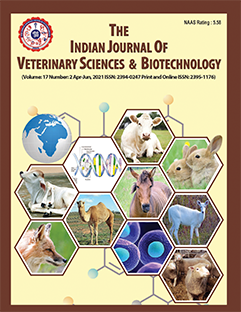Treatment of Septicaemic Cutaneous Ulcerative Disease in an Indian Flap Shell Turtle: A Case Report
DOI:
https://doi.org/10.48165/ijvsbt.21.4.36Keywords:
turtles, rising, popularity, Septicaemic, Cutaneous, Ulcerative, DiseaseAbstract
Slowly but surely, turtles have become the pet of choice for many, rising to popularity in recent years. Septicaemic Cutaneous Ulcerative Disease (SCUD) or Shell rot is a critical issue in aquatic turtles and some reptiles caused by a bacterial or fungal infection. This may occur due to lack of knowledge of housing, i.e., keeping the turtles in dirty water or providing mouldy bedding and some environmental factors like high humidity and low temperatures are responsible for the occurrence of this disease (Lingayat et al., 2022). If proper measures for the control of shell rot are not taken, it can cause rot through the bone and into the body cavity (Khan et al., 2019). The Gram-negative bacteria that are normally present in the environment are the most common cause of bacterial infection (Kasim et al., 2017). Affected turtles show clinical signs such as presence of white spots on shell and hyperaemia in early stages of the disease, later cutaneous ulceration and fibrin deposit on the shell can be seen (Fowler and Miller, 2008; Jadhav et al., 2020). This documentation describes the successful treatment of septicaemic cutaneous ulcerative disease in an Indian flap shell turtle.
Downloads
References
1. Fowler, M.E., & Miller, R.E. (2008). Zoo and Wild Animal Medicine: Current Therapy (Vol. 6). Elsevier Health Sciences.
2. Hoppmann, E., & Barron, H.W. (2007). Dermatology in reptiles. Journal of Exotic Pet Medicine, 16(4), 210–224.
3. Jadhav, R.K., Chavhan, S.G., & Bhikane, A.U. (2020). Therapeutic management of shell rot in red-eared turtle (Trachemys scripta elegans). Journal of Wildlife Research, 8, 1–3.
4. Kasim, A.M., Senthil Kumar, K., & Palanivelrajan, M. (2017). Shell rot infection in red eared turtle. International Journal of Advanced Biological Research, 7(3), 634–635.
5. Khan, S., Satheesh, A., Panikkassery, S., & Sidhique, S.A. (2019). Therapeutic management of conjunctivitis and shell rot in a red-eared slider (Trachemys scripta elegans). Journal of Dairy Veterinary and Animal Research, 8(1), 22–24.
6. Lingayat, S.S., Chaunde, D.S., Shafi, T.A., Sakhare, M.P., Siddiqui, M.F.M.F., & Syed, A.M. (2022). Shell rot infection in a red eared turtle. Indian Journal of Veterinary Medicine, 42(2), 116–118.
Downloads
Published
Issue
Section
License
Copyright (c) 2025 Indian Journal of Veterinary Sciences and Biotechnology

This work is licensed under a Creative Commons Attribution-NonCommercial-NoDerivatives 4.0 International License.




